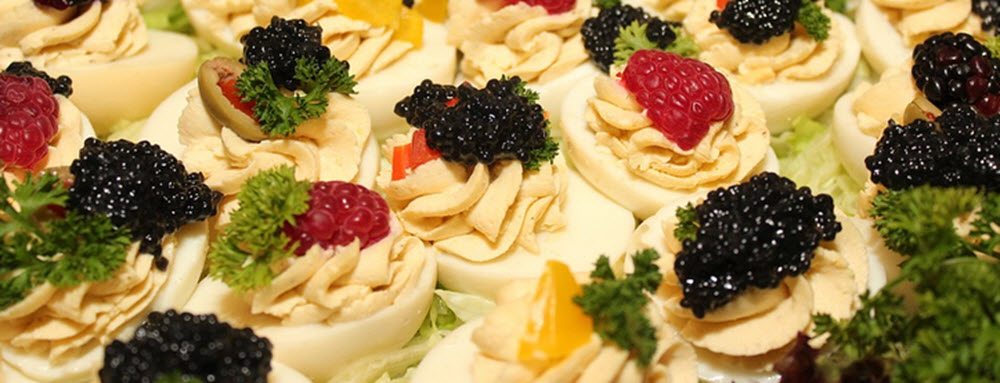Caviar alternatives
All caviar is roe, but not all roe is caviar
Only salt-cured roe from fish of the order Acipenseriformes is considered true caviar. The order Acipenseriformes includes two extant families: Acipenseridae (the sturgeons) and Polyodontidae (the paddlefishes).
There are also some even more picky purists who only consider a product true caviar if it is the salt-cured roe from wild sturgeons caught in the Caspian Sea or the Black Sea.
With that said, there are many fish roe products that taste great even though are not made from Acipenseriformes roe, and there are also excellent roe products that are prepared in other ways than traditional caviar-style salt-curing.
If you are interested in exploring the culinary world of fish roe, there is no reason to limit yourself to salt-cured Acipenseriformes roe.

Non- Acipenseridae roe
Examples of good places to start your exploration of non-Acipenseridae roe are salmon roe, lumpfish roe, carp roe, and trout roe products.
In Europe, there is a strong tradition of eating salt-cured lumpsucker (Cyclopterus lumpus) roe, which is sold in small glass jars and enjoyed as delicacy. Vendance (Coregonus albula) roe and European whitefish (Coregonus lavaretus) roe are similarly popular.
Lumpfish roe
Lumpsucker, also known as lumpfish, is a marine fish living in the North Atlantic and adjacent parts of the Arctic Ocean. Along the European Atlantic coast, they are occasionally caught as far south as Spain, but are considered rare south of the English Channel.
Data for the period 1977-2018 show that the annual landings of lumpfish roe varied from circa 2,200 metric tons to circa 8,000 metric tons. Female fish are targeted, as the roe is more sought after than the fish itself. Currently, the main lumpfish fishing nations are Iceland and Greenland, who combined account for around 95% of the total catch. In Norway and Canada, lumpfish fishing has decreased as a reaction to dropping prices for roe.
Lumpfish come closer to shore when it is time to spawn, so fishing operations looking for roe typically use small fishing boats and large mesh gillnets to catch them near land. Male lumpfish are smaller, so they are less likely to get entangled in the large-mesh nets.
Traditionally, the roe would be removed on the ship and the fish bodies thrown back into the sea. Today, it is more common to land the fish, freeze it and export it to China.
Bowfin roe
If you are in North-America, it should be fairly easy for you to locate roe products made from Bowfin (Amia calva) roe. Bowfish roe is produced throughout the southern United States, including Louisiana where bowfin is both farmed and caught in the wild. Bowfin belongs to the order Amiiformes and produces eggs that are small, dark and firm. Bowfin is native to North America and is found in places such as the Great Lakes, the Mississippi River drainage basin, and several rivers that empty themselves in the Eastern Seaboard or Gulf of Mexico. They spawn between April and June, and the number of eggs produced is linked to the size of the female. Really large specimens can contain over 55,000 eggs.
What is smörgåskaviar?
Smörgåskaviar (Finnish: Mätitahna) is a fish roe spread popular in the Nordic countries. It is made from cod roe but is not only cod roe, and you can buy both smoked and non-smoked versions of smörgåskaviar.
The exact recipe for smörgåskaviar vary depending on which brand and product you by. In the Nordict countries, there are a lot of different smörgåskaviar products available to choose from. Examples of common ingredients, in addition to smoked or non-smoked cod roe, are potato flakes, tomato sauce, onion, salt, dill, and chives. Smörgåskaviar is typically sold in metallic tubes, which makes the product easy to squeeze onto a sandwich.
Vegan alternatives to caviar and other roe products
If you want that special wild and salty flavour of caviar, but without involving animals, there are several vegan options available. People buy them for a variety of reasons, including animal rights, religious, health, and environmental concerns, or because they simply prefer them over roe.
Many vegan alternatives to caviar are produced from seaweeds, such as Laminaria Hyperborea, a brown algae native to the northern Atlantic and the Baltic Sea.
There are vegan caviar substitutes available that look very much like roe. Some look so similar to classic beluga caviar that they are used as props in movies and TV-series.
